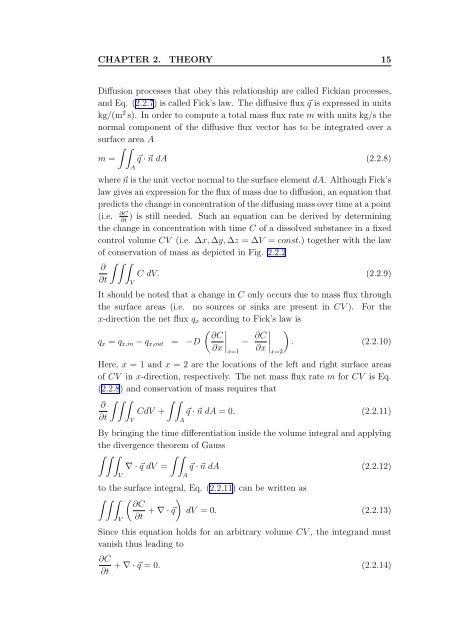Three-dimensional Lagrangian Tracer Modelling in Wadden Sea ...
Three-dimensional Lagrangian Tracer Modelling in Wadden Sea ...
Three-dimensional Lagrangian Tracer Modelling in Wadden Sea ...
Create successful ePaper yourself
Turn your PDF publications into a flip-book with our unique Google optimized e-Paper software.
CHAPTER 2. THEORY 15<br />
Diffusion processes that obey this relationship are called Fickian processes,<br />
and Eq. (2.2.7) is called Fick’s law. The diffusive flux �q is expressed <strong>in</strong> units<br />
kg/(m2 s). In order to compute a total mass flux rate m with units kg/s the<br />
normal component of the diffusive flux vector has to be <strong>in</strong>tegrated over a<br />
surface area A<br />
� �<br />
m = �q · �n dA (2.2.8)<br />
A<br />
where �n is the unit vector normal to the surface element dA. Although Fick’s<br />
law gives an expression for the flux of mass due to diffusion, an equation that<br />
predicts the change <strong>in</strong> concentration of the diffus<strong>in</strong>g mass over time at a po<strong>in</strong>t<br />
(i.e. ∂C<br />
∂t<br />
) is still needed. Such an equation can be derived by determ<strong>in</strong><strong>in</strong>g<br />
the change <strong>in</strong> concentration with time C of a dissolved substance <strong>in</strong> a fixed<br />
control volume CV (i.e. ∆x, ∆y, ∆z = ∆V = const.) together with the law<br />
of conservation of mass as depicted <strong>in</strong> Fig. 2.2.2<br />
� � �<br />
∂<br />
∂t<br />
C dV. (2.2.9)<br />
V<br />
It should be noted that a change <strong>in</strong> C only occurs due to mass flux through<br />
the surface areas (i.e. no sources or s<strong>in</strong>ks are present <strong>in</strong> CV ). For the<br />
x-direction the net flux qx accord<strong>in</strong>g to Fick’s law is<br />
� �<br />
∂C �<br />
qx = qx,<strong>in</strong> − qx,out = −D � −<br />
∂x<br />
∂C<br />
� �<br />
�<br />
� .<br />
∂x<br />
(2.2.10)<br />
� x=1<br />
Here, x = 1 and x = 2 are the locations of the left and right surface areas<br />
of CV <strong>in</strong> x-direction, respectively. The net mass flux rate m for CV is Eq.<br />
(2.2.8) and conservation of mass requires that<br />
∂<br />
∂t<br />
� � �<br />
V<br />
� �<br />
CdV +<br />
A<br />
� x=2<br />
�q · �n dA = 0. (2.2.11)<br />
By br<strong>in</strong>g<strong>in</strong>g the time differentiation <strong>in</strong>side the volume <strong>in</strong>tegral and apply<strong>in</strong>g<br />
the divergence theorem of Gauss<br />
� � �<br />
� �<br />
∇ · �q dV = �q · �n dA (2.2.12)<br />
V<br />
A<br />
to the surface <strong>in</strong>tegral, Eq. (2.2.11) can be written as<br />
� � � � �<br />
∂C<br />
+ ∇ · �q dV = 0.<br />
∂t<br />
(2.2.13)<br />
V<br />
S<strong>in</strong>ce this equation holds for an arbitrary volume CV , the <strong>in</strong>tegrand must<br />
vanish thus lead<strong>in</strong>g to<br />
∂C<br />
∂t<br />
+ ∇ · �q = 0. (2.2.14)

















